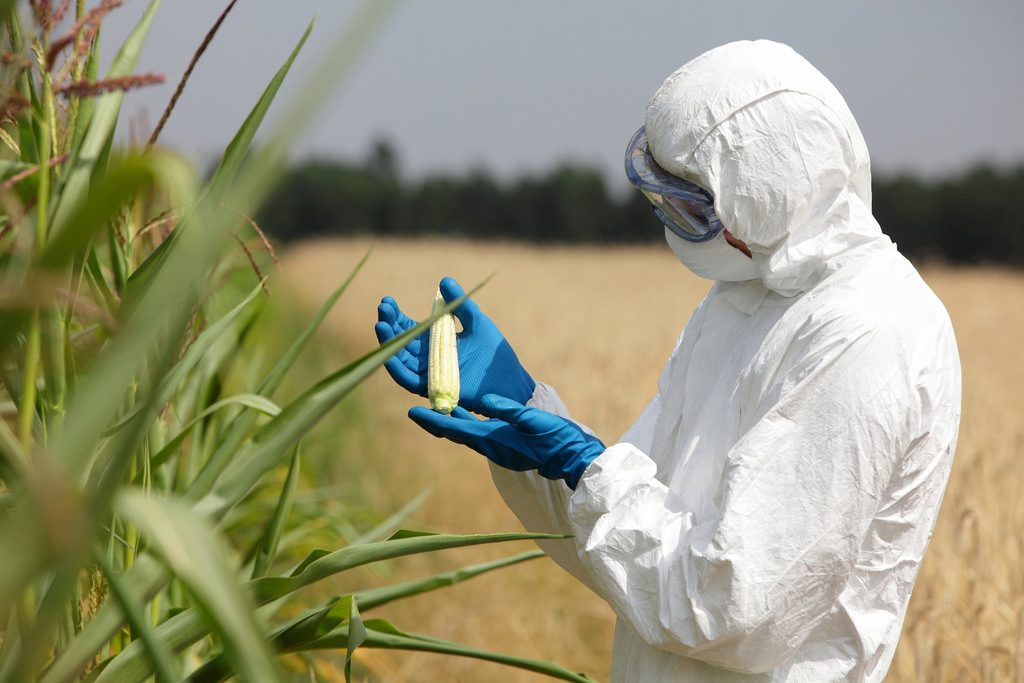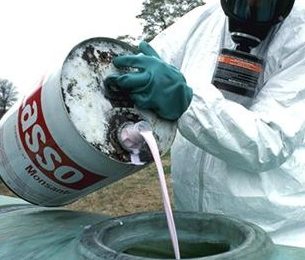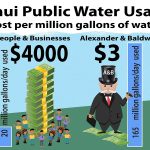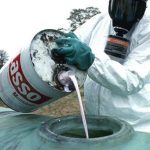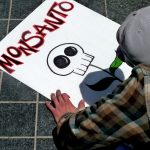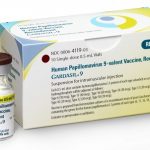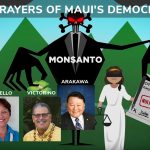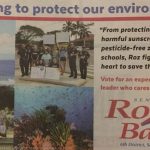The agro-chemical giant Monsanto has painted itself as a kindly company bringing needed jobs to Maui and Molokai. They neglect to mention in their PR that they are drenching Maui’s farm land with dangerous cocktails of toxic pesticides.
In their official 2015 report prepared for the County of Maui, under the heading Restricted Use Pesticides in Maui County, Monsanto identified 17 pesticides they spray here, including four banned in Europe.
Under a Memorandum of Understanding between Monsanto and the County of Maui annual reports detailing Restricted Use Pesticides are supposed to be released within 60 days of the close of a calendar year. More than 100 days since the close of 2016, Monsanto has still not posted their latest report.
As reported recently here on the Maui Independent, efforts to pass common sense statewide pesticide disclosure laws were recently torpedoed in the hidden halls of backdoor power. Hopes had run high for a proposed bill that would have helped inform and empower Hawaii’s residents about the impact of restricted use pesticides. But House Bill 790 sank after pushback from the powerful biotech industry and resistance from the old guard.
In a preface to their 2015 Maui county report Monsanto boldly proclaimed: “Integrity is the foundation for all that we do.” And that, “we are committed to Transparency and Respect – We will respect the religious, cultural, and ethical concerns of people throughout the world.”
For an extra laugh Monsanto brazenly announced: “We care deeply about protecting our island’s natural resources and strive daily to preserve the land for future generations.”
To many in Maui, and around the world, preserving land for future generations seems like the opposite of what the company actually does. On Tuesday, the Mosanto Tribunal operating in The Hague (Netherlands), published the conclusion of their six-month investigation which essentially found that Monsanto’s chemical stew of agriculture results in the poisoning, and not the protecting, of land.
Reviewing the evidence, the Tribunal’s five judges concluded: “If such a crime of ecocide were recognized in international criminal law, the activities of Monsanto could possibly constitute” such a crime, citing its dissemination of “dangerous agrochemicals in industrial agriculture;” “the engineering, production, introduction, and release of genetically engineered crops;” and “the introduction of persistent organic pollutants such as PCB into the environment.”
The panel of judges heard some 30 witnesses from countries as diverse as Argentina, Bangladesh, Canada, Burkina Faso and Sri Lanka about the various impacts of chemicals on the environment.
The judges wrote: “The advisory opinion is a strong signal to those involved in international law, but also to the victims of toxic chemicals and corporate power. Companies that cause damage to health, food, and the environment should and will be held accountable for their actions.”
Monsanto, which was recently named one of the 2017 World’s Most Admired Companies by Fortune Magazine, took umbrage at the report releasing an open letter in reaction. The company says the tribunal, “was staged by a select group of anti-agriculture technology and anti-Monsanto critics who played organizers, judge and jury.”
How then does Monsanto “strive daily to preserve the land for future generations” on Maui – by dousing their GMO seed crops with the following laundry list of toxic chemicals.
Atrazine 4L – Atrazine is the common name for an herbicide that is widely used to kill weeds. According to Monsanto 398 acres in Maui County were sprayed with 105 gallons of astrazine in 2015.
One of the primary ways that atrazine can affect health is by altering the way that the reproductive system works. Studies of couples living on farms that use atrazine for weed control found an increase in the risk of pre-term delivery. Atrazine has been shown to cause changes in blood hormone levels in animals that affected the ability to reproduce.
California’s Office of Environmental Health Hazard Assessment has added atrazine to the list of chemicals known to cause reproductive toxicity. Atrazine has also caused liver, kidney, and heart damage in animals.
The European Union (EU) banned atrazine in 2004, because of ubiquitous and unpreventable water contamination. According to a report in the International Journal of Occupational and Environmental Health, the authors reviewed regulatory procedures and government documents, “and reported efforts by the manufacturer of atrazine, Syngenta, to influence the U.S. atrazine assessment, by submitting flawed scientific data as evidence of no harm, and by meeting repeatedly and privately with EPA to negotiate the government’s regulatory approach. Many of the details of these negotiations continue to be withheld from the public.”
Because it is banned in Europe, the Switzerland’s Syngenta can not sell their pesticide anywhere in their homeland.
In June 2016 the Environmental Protection Agency (EPA) released a 500-page draft report on the environmental impacts of atrazine. The agency concluded that atrazine poses a potentially serious ongoing risk to birds, mammals, fish, frogs as well as many plants it was not designed to kill.
Atrazine is generally sprayed on corn and other crops, but it doesn’t stay on farm fields, often ending up in our nation’s surface and groundwater. The EPA’s report found that levels of this herbicide in the environment exceed what the agency considers “levels of concern for chronic risk” by as much as 22, 198, and 62 times for birds, mammals, and fish, respectively.
Almost 90 percent of drinking water in the U.S. has atrazine in it, according to an analysis of U.S. Department of Agriculture data by the Pesticide Action Network.
Gramoxone Inteon (paraquat dichloride) – Paraquat is exceedingly toxic to humans. In 2000, a meta-analysis linked confirmed and presumed pesticide exposure with increased risk of Parkinson’s. A 2009 UCLA study found that a person exposed to paraquat and two other pesticides is three times as likely to develop Parkinson’s disease.
In 2011, a US National Institutes of Health study showed a link between paraquat use and Parkinson’s disease in farm workers. Paraquat increases production of certain oxygen derivatives that may harm cellular structures, and that people who used paraquat, or other pesticides with a similar mechanism of action, were more likely to develop Parkinson’s.
Paraquat is banned in 32 countries including all EU states, China and South Korea. The EU voted to ban paraquat in 2007, and China approved a ban in 2012.
Cobalt Advanced (lambda-cyhalothrin) – Lambda-cyhalothrin is highly toxic to bees and very toxic to fish and other aquatic organisms. It is very toxic to terrestrial vertebrates such as birds and reptiles. Researchers have found that chronic exposure to both lambda-cyhalothrin and imidacloprid impacts bees’ natural foraging behavior. Lambda-cyhalothrin is a suspected endocrine disruptor. Cyhalothrin is banned in the EU.
Intrro/Micro-Tech (Alachlor) – Alachlor is a highly toxic chemical that is widely considered an endocrine disruptor. It has been linked to kidney and liver damage as well as birth and developmental defects. A 2004 study linked alachor with lymphohematopoietic cancer among agricultural workers.
In 1987, Massachusetts attempted to ban alachlor after the known human carcinogen was discovered in drinking water. Monsanto successfully convinced the state’s pesticide board to make alachlor a restricted use chemical rather than banning it.
In January, 2012 a French court found Monsanto, which manufactures Lasso (alachlor), guilty of chemical poisoning of a French farmer in 2004. The court ruled: “Monsanto is responsible for Paul Francois’s suffering after he inhaled the Lasso product … and must entirely compensate him.”
Since 2007, alachlor has been banned as a herbicide in the European Union. It is also banned in Canada.
Permethrin – The EPA has classified permethrin as a likely carcinogen because it causes lung tumors in female mice and liver tumors in mice of both sexes. An insecticide in the pyrethroid family, permethrin affects the nervous system in insects, causing muscle spasms, paralysis and death.
Permethrin inhibits the activity of the immune system in laboratory tests, and also binds to the receptors for a male sex hormone. It causes chromosome aberrations in human and hamster cells. Permethrin is toxic to bees and other beneficial insects, and is highly toxic to fish and other animals that live in either salt water or fresh water.
In a 2015 study, children with detectable permethrin residues in their urine were twice as likely to be diagnosed with ADHD as children with non-detectable levels of the pesticide. A 2017 French study, published in the journal Occupational and Environmental Medicine, linked childhood behavioral problems to pyrethroid insecticide exposure.
A US study investigated the effects of combining permethrin and DEET (as insect repellants), found that mixing the chemicals can have serious side effects. Clinical tests showed that the combinations of both resulted in diarrhoea, weight loss, gait disturbances, body tremors and death. The combination is a suspected cause of Gulf War Syndome. Permethrin has been banned in the EU for crop use since 2000.
Lorsban 4E & Lorsban Advanced (chlorpyrifos) – Chlorpyrifos is toxic to birds and wildlife and extremely toxic to fish. Prolonged excessive exposure to mist may cause serious adverse effects, even death. Breathing the air in an area in which chlorpyrifos has recently been sprayed may produce a variety of effects on the nervous system including headaches, blurred vision, watering of the eyes, excessive salivation, runny nose, dizziness, confusion, muscle weakness or tremors, nausea, diarrhea, and sudden changes in heart rate. It has caused cancer in laboratory animals.
Chlorpyrifos’s neurotoxicity led to its 2000 ban from numerous residential uses. A 2004 study evaluated the incidence of cancer among pesticide applicators exposed to chlorpyrifos, finding higher rates of lung cancer than normal.
A Yale University study in 2015 found that prenatal exposure to chlorpyrifos is linked to tremors – involuntary contraction or twitching of muscles – in childhood.
Researchers have found chlorpyrifos in indoor air, dust, carpets, and on children’s toys in homes where products with chlorpyrifos in them had been used.
Lannate LV Insecticide (Methomyl) – Methomyl is toxic to fish and wildlife. Drift and runoff from treated areas is hazardous to aquatic organisms in neighboring areas. It is highly toxic to bees exposed to direct treatment on blooming crops or weeds.
In 2015, methomyl manufacturers agreed to voluntarily cancel certain uses of the pesticide because of EPA’s estimates of drinking water risks for the use of methomyl in agricultural settings. Actions taken include: canceling the use of methomyl on barley, oat, and rye; limiting its use on wheat to Idaho, Oregon, and Washington; and reducing the number of applications for corn, celery, and head and leaf lettuce.
Asana XL (Esfenvalarate) is a restricted-use pesticide because it is highly toxic to fish and aquatic invertebrates. Asana XL is also highly toxic to bees. Searching for clues to the mysterious disappearance of bees, “colony collapse disorder,” in 2010, Penn State University researchers identified widespread pesticide contamination of beehives. The top most frequently detected pesticides include esfenvalerate, chlorpyrifos, and atrazine.
Esfenvalerate’s manufacturer, Sumitomo Chemical, filed a lawsuit in 2001 in the Danish High Court against the Danish Environment Minister and the Danish Environmental Protection Agency after the Nordic nation tried to ban esfenvalerate.
Baythroid XL (beta-cyfluthrin) – This pesticide is extremely toxic to fish, aquatic invertebrates and bees. Use instructions include: “Do not apply this product or allow it to drift to blooming crops or weeds on which bees are actively foraging.”
Dual II Magnum (S-metolachlor) (sprayed on 387 acres of Maui land) – The active ingredient in Dual II Magnum has the potential to leach through soil into ground water. Evidence of the bioaccumulation of metolachlor in edible species of fish as well as its adverse effect on the growth and development raise concerns on its effects on human health.
Mustang Max (zeta-cypermethrin) – It is extremely hazardous to bees. Zeta-cypermethrin is considered highly toxic to fish and aquatic arthropods and slightly toxic to birds.
Simazine (Princep) – Simazine is a triazine herbicide. The EPA classifies it a possible carcinogen. It is toxic to aquatic invertebrates. Its use is severely restricted in the EU.
Warrior with Zeon Technology & Warrior II with Zeon Technology (lambda-cyhalothrin) – This pesticide is extremely toxic to fish and aquatic organisms and toxic to wildlife. This product is highly toxic to bees exposed to direct treatment or residues.
Force 3.0G – Highly toxic to aquatic invertebrates and fish. Usage directions suggest: Use Force 3g insecticide only once per year.
Coragen – Studies have demonstrated that it has low toxicity to mammals, fish and birds along with high insecticidal potency.


